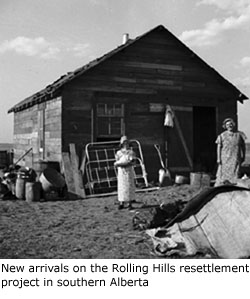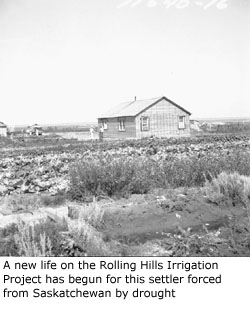LAND RESETTLEMENT
In general, agricultural settlement in Canada comes under provincial jurisidiction. For this
reason,
federal government resettlement work had been largely limited to the relocation of farmers
removed
from community pastures, and to settlement on large irrigation projects.
One exception occurred in 1936 when Prairie Farm Rehabilitation Administration (PFRA)
organization co-operated with provincial
authorities
in transferring 63 farmers from dried-out areas in Saskatchewan to better locations elsewhere, by
paying freight charges on effects and livestock.

Actual settlement work conducted under PFRA began in
1939 under authority of Order-in-Council P.C. 2168 dated August 2, 1939. Under the terms of
the
agreement with Saskatchewan, provincial crown lands were made available for resettlement, with
the
federal government assuming financial responsibility for resettlement of farmers. A similar
agreement
was signed the following year with Manitoba, to facilitate land utilization and resettlement
in that
province. By 1940, one hundred and forty-five farmers had been moved under the plan.
When the supply of public land had run out, families were moved to irrigable lands in southern
Alberta. The Rolling Hills project, built near Brooks, was the first large-scale resettlement onto
irrigated land. Development of the Rolling Hills irrigation project,
specifically to provide
for the resettlement of farmers moved from dried-out areas, was started in 1937 as a co-operative
program between Eastern Irrigation
District in Alberta and PFRA. Under this arrangement, irrigable land was made available to
settlers
selected by the PFRA Land utilization branch. The District provided the main water supplies,
constructed roads and assisted in the introduction of various social services. Preparation of land
for irrigation farming and supervision of settlement were undertaken by PFRA.
In the following two years, the old works constructed for this area were refurbished and the land
was leveled under a cost-sharing arrangement with the Eastern Irrigation District. Settlers began
to arrive on the project from southern Saskatchewan in the fall of 1939.
Settlement was completely voluntary. Each settler considering a move was taken to Rolling Hills
prior to acceptance, to inspect the land and the district, and to see for himself just what irrigation
meant in terms of work and effort and what could be expected as a result of irrigation. If desired,
passenger fares were advanced to move his family. His stock, building materials, equipment, and
personal effects were shipped by box car. Many families even moved the lumber from their
homes, barns and other buildings. PFRA broke 100 acres on each quarter section at a nominal
cost, and provided feed supplies and seed for the first year's crop. The overall policy was to assist
new settlers in every way possible, to speed and facilitate their resettlement and rehabilitation.
Sale price of the land was $8 per irrigable acre. Settlers paid an annual water rate of $1.60 per
irrigated acre, plus 10 cents per acre for hail insurance. The foregoing conditions of sale and
occupancy were designed to afford reasonable opportunity to eligible settlers.

By the summer of 1942, settlers had been
placed on 180 quarter sections. In only three cases did settlers prove unsatisfactory. By 1942 a
large
proportion
of the land in this project, which in 1937 was open range, was under irrigated crops, largely grain
and
alfalfa. The area was well adapted to the production of vegetables for canning. In 1942, over
3,000
acres were under peas for seed. The absence of pea-weevil, destructive elsewhere, favoured this
crop in the Rolling Hills area. Of these some 1,500 acres of peas were under
contract for
the production of seed for shipment to England.
Suitable crown lands available for resettlement were limited and were quickly used up.
In order to address the increased demand, it was necessary to provide improved land through
large-scale irrigation development. Other PFRA irrigation projects which offered resettlement
possibilities were located in
Saskatchewan at
Val Marie, Eastend, and Maple Creek. These projects, with an aggregate of 11,945 acres under
irrigation in 1940, and with room for some expansion, afforded opportunity for the eventual
settlement of
over 200 farmers. In each of these projects, all of which were adjacent to extensive acres of
rangeland,
the policy was adopted of disposing of irrigable land in small blocks from 40 to 60 acres, with
the
object of promoting the production of forage crops as reserve or supplementary feed for range
livestock.
Two further projects were undertaken in 1942: the Swift Current Irrigation project with an
irrigation
development potential of 25,000 acres of dry land and river bottom; and the Consul irrigation
Project in
the extreme southwestern corner of Saskatchewan, with a total irrigable area of 4,500 acres.
Moving, building new homes and making the switch from dryland to irrigation farming were not
easy tasks, but for farmers struggling on blown-out land, it was often the only chance for a better
future.

